
A Whittlesea councillor has called for greater protections for the municipality’s old dry stone walls, many of which have been around for more than 150 years.
Cr Rex Griffin has questioned the strength of the council’s updated heritage and conservation policy when it comes to protecting dry stone walls from development.
At last week’s council meeting, he called for more punitive powers when developers or private property owners demolish the old walls.
“Developers are just coming through, and all those walls will go. What checks have we got?
“There is nothing to bind the policy. There’s no punishment. Once those walls are gone they’re gone,” he said.
Dry stone walls are built without cement or mud. In Whittlesea, they were built by settlers using a variety of local rocks, including bluestone and honeycomb, to mark property boundaries and keep rabbits at bay.
Dry Stone Walls Association of Australia president Jim Holdsworth supported Cr Griffin’s call for tougher protections in Whittlesea.
He suggested the council follow the lead of Wyndham and Melton, whose councils surveyed every dry stone wall before identifying the best examples and formally protecting them in local planning schemes.
“We do support … formal mechanisms to retain the best, most representative, dry stone walls,” Mr Holdsworth said.
Whittlesea’s current policy is “to avoid demolition of dry stone walls” and support the retention and sympathetic integration of old walls into new developments and subdivisions.
Mr Holdsworth said there were some good examples in Whittlesea where developers had retained dry stone walls on their land.
Some of the best examples were at the old Creeds Farm at Epping and on the south side of Harvest Home Road, he said.
The council’s established areas planning manager Darren Jackson said it could prosecute landowners who illegally demolish walls.








